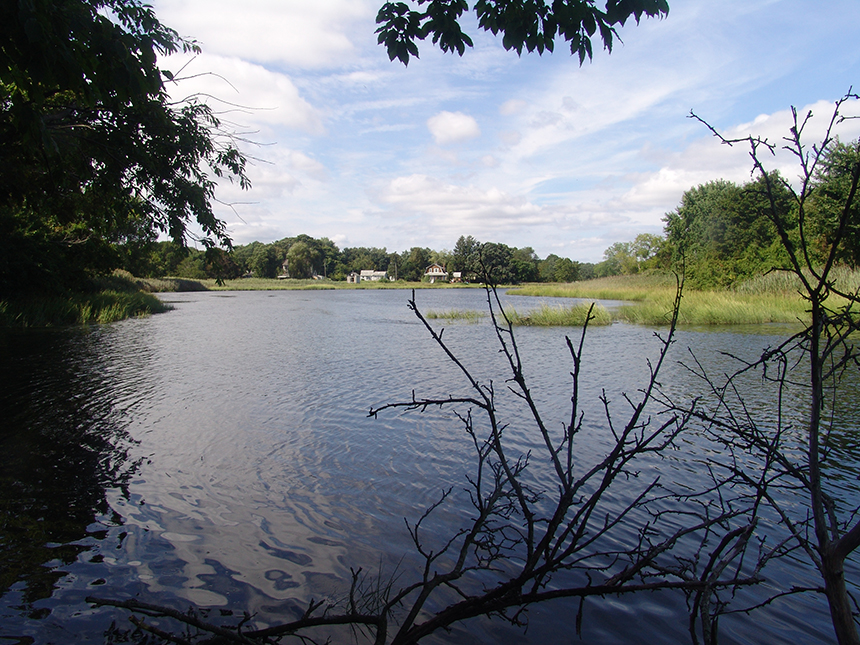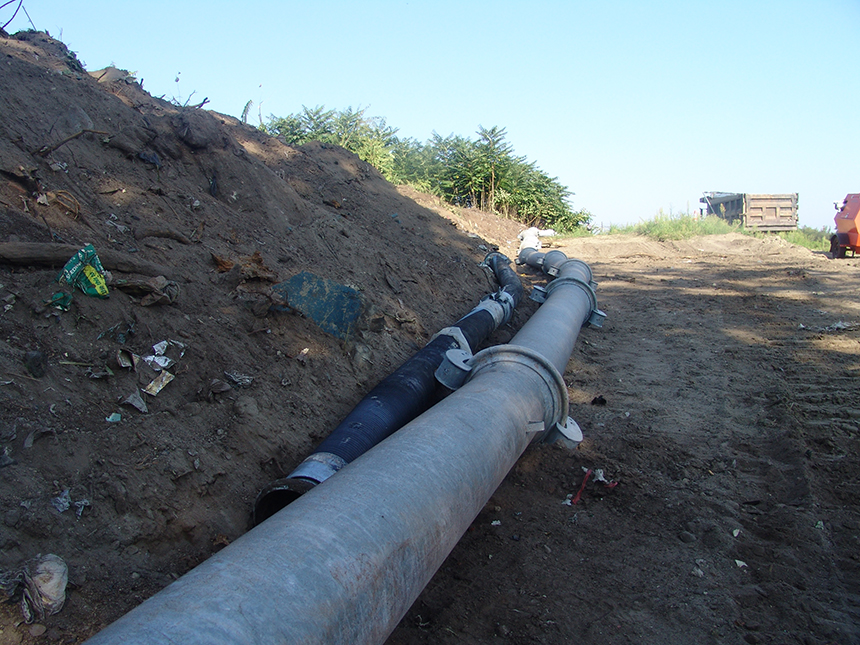Burst Sewer Pipe Floods Warwick Basements and Brook
Replacing aging infrastructure before it lets loose is a statewide problem
September 1, 2018
WARWICK, R.I. — Last Sunday evening, when a concrete sewer line collapsed and unleashed an estimated 300,000 gallons of untreated sewage, two homeowners on Armory Drive and another on Trent Avenue were among the first places to smell the problem.
While one of the Armory Drive homeowners only had to deal with about a gallon of wastewater, the other was left with a basement filled with several feet of raw sewage. The Warwick Sewer Authority put the family up in a local hotel.
The Trent Avenue home’s basement also was flooded badly, but since it’s unfinished, the damage was less problematic. The owner opted to stay with his daughter, and the Warwick Sewer Authority’s insurance company also paid for this cleanup.
The Aug. 26 sewage backups at these three homes were what alerted Janine Burke-Wells, executive director of the Warwick Sewer Authority, to the messy problem. By checking manholes in that section of the city, not far from T.F. Green, her staff quickly found the collapsed line, 22 feet under Cedar Swamp Road, a dead-end street that abuts airport property. Two sink holes caused by the sewer line collapse were found in a nearby field. The biggest measured 20 feet by 10 feet.
It took the city’s sewer authority five hours to bypass the damaged area, using about 100 feet of interlocking metal pipe. Two mobile compressor stations are running 24/7 to keep the temporary bypass operational.
Burke-Wells said the replacement work is expected to take about two weeks. Hitting water, she said, would complicate matters.
She gave ecoRI News a tour of the Cedar Swamp Road worksite Aug. 29, telling us she believes the 36-inch reinforced concrete pipe that leads to the Cedar Swamp pump station, the city’s largest, was compromised by years of hydrogen sulfide corrosion. The concrete pipe, which was laid in 1978, will be replaced by a sturdier polyvinyl chloride (PVC) sewer line.
The Cedar Swamp pump station takes in 1.5 million of the 4.5 million gallons of wastewater handled daily by Warwick’s public sewer system. Odor complaints — the rotten-egg smell of hydrogen sulfide — have been logged by residents in this area for years.
Warwick’s public sewer system has about 27,000 customers, about 65 percent of the city.

Fragile ecosystem
The discharge that didn’t back up into nearby homes ended up in Buckeye Brook, a tidal waterway that drains into Mill Cove — about 3 miles downstream of the Cedar Swamp pump station — and eventually into Narragansett Bay. It’s a sensitive ecosystem in the middle of suburban development that includes an international airport. Burke-Wells said the discharge point was about 300 feet from the brook. The sewer authority set up a chlorine drip for disinfection during the discharge.
“We believe some of the spill may have been absorbed by the natural vegetation and topography of that area, but we reported 300,000 gallons based on known flows through that manhole and the length of time of the discharge,” she said.
On Aug. 27 the Rhode Island Department of Environmental Management (DEM) and the Department of Public Health (DOH) announced the closing of upper Narragansett Bay, from Conimicut Point to Nayatt Point on Prudence Island, to shellfishing and advised that any shellfish harvested near the outlet of Old Mill Creek not be eaten until further notice.
Nearby Conimicut Beach also was closed.
On Aug. 31, DEM reduced the area of the emergency closure of upper Narragansett Bay to shellfishing to about a 2-mile stretch of Warwick’s 39-mile coastline, from the DEM range marker on Conimicut Point in the north to the extension of Ogden Avenue in the Highland Beach area in the south.
DOH also recommended the continued closure of Conimicut Point Beach for swimming until further notice.
Buckeye Brook and Warwick Pond, an 85-acre pond in the middle of Warwick, just east of the airport, are the spawning grounds of blue back herring and alewives. The brook and its salt marshes play a vital role as a natural filtration system and vegetative buffer for Narragansett Bay. It’s also a spawning ground for shrimp and other smaller bay inhabitants. Shorebirds feed on the watershed’s fish, worms, crabs, and clams. The Buckeye Brook watershed is home to river otters, painted turtles, and American eels.
“This area is unique in that it is a small brook that cannot take 300,000 gallons of sewage very easily,” said George Shuster, a River Vue Avenue resident whose property borders Mill Cove and lower Buckeye Brook. “It is only barely tidal up at Cedar Swamp and has been compromised for decades for various reasons, so it will take a long time for nature to resolve it by itself. The bacteria is one thing, but the solids and chemicals are another.”
Buckeye Brook is impaired by cadmium, copper, and iron contamination, and it suffers from low levels of dissolved oxygen, according to Rhode Island’s most recent impaired waters report. The presence of enterococcus, a type of bacteria found in the intestines of warm-blooded animals that indicates the presence of raw sewage, and fecal coliform make the brook unsafe for recreational activities.
ecoRI News visited with Shuster on Aug. 31. He said he regularly swims and fishes in Mill Cove. He said people regularly shellfish in the area, in both legal and illegal locations. He noted that he could smell the discharge at his home on Aug. 26 and Aug. 27, and that a faint smell remained for the rest of the week. ecoRI News didn’t notice any smell during our late-morning visit on Friday.
Shuster also was concerned by how slow the public was made aware of the problem and its related health concerns.
“The public had no idea this happened until a day later,” he said. “The accident happened Sunday evening and the public was alerted Monday morning and told not to eat shellfish harvested from that area. What happens if you had?”
The state of Rhode Island sent out a press release on the morning of Aug. 27. The discharge was discovered at 5:30 p.m. on Aug. 26.

Infrastructure costs
Decades ago, federal grant money helped sewer parts of this former farming community, but that money dried up long ago. Funding for wastewater infrastructure upgrades, such as replacing half-century-old concrete sewer lines with PVC or HOBAS — an Austria-based manufacturer of centrifugally cast glass-fiber reinforced systems made of unsaturated polyester resin — pipe is even harder to come by.
While some communities wait for emergencies, like the collapse of a 40-year-old sewer line, to get the money needed fix known problems, Burke-Wells has spent her 10 years as the sewer authority’s lead trying to address problem areas before they burst. Money, or more specifically a lack of it, makes proactive measures to replace aging infrastructure buried out of sight a constant game that plays out statewide.
“We could put a lot of people to work fixing this infrastructure effectively,” Burke-Wells said. “And the costs could be shared, but there’s no support for this on the municipal side.”
Burke-Wells told ecoRI News that $50 million over five years would allow the sewer authority to make the remaining upgrades to a system that features 300 miles of sewer line — sections of which were laid in the 1960s and ’70s — and 48 pump stations. She said PVC and HOBAS pipe last for about 75 years.
Here is a look at major infrastructure repairs made in Warwick during the past few years, according to Burke-Wells:
2015: main influent pipe. A 48-inch reinforced concrete mainline rehabilitated using HOBAS pipe. Cost was about $800,000 for about 600 feet of pipe.
2016: Interstate 295 bridge pipe. A total of 400 feet of 16-inch ductile iron pipe installed under the East Avenue bridge that goes over Interstate Route 295 was treated for external corrosion (road salt) and structurally rehabilitated using a patented coating. Cost was about $150,000.
2017: Drum Rock School infrastructure. Replaced six deteriorated concrete manholes on school property — pipe takes flows for numerous businesses on Route 2. Cost about $60,000. The pipe was PVC so not susceptible to corrosion
2018: Airport Road interceptor. A 48-inch reinforced concrete pipe rehabilitated using HOBAS pipe. Cost was about $400,000 for 400 feet.
Much of this work was funded by the removal and replace fee on the city’s quarterly sewer bills, which amounts to about $13 a year per customer. Burke-Wells said the sewer authority collects and records data regarding the condition of system sections — age, materials used, risk of failure — and tries to clean and inspect a fifth of the system annually.




Wow! Why is this the first I’m hearing about this? What an absolutely devastating thing to happen to an already compromised ecosystem. Our waterways, streams and ponds should be protected at all costs from events like this from happening.
This was a problem for 2 years and they knew it but did nothing about it. Now sewage is in 2 houses. This other article says people complained about it at least 2 years ago. The Cedar Swamp resident had to put up with the rotten egg smell for 2 years and the Brookeye Pond is now contaminated. This is pathetic.
From January 2016
http://www.providencejournal.com/article/20160121/NEWS/160129761